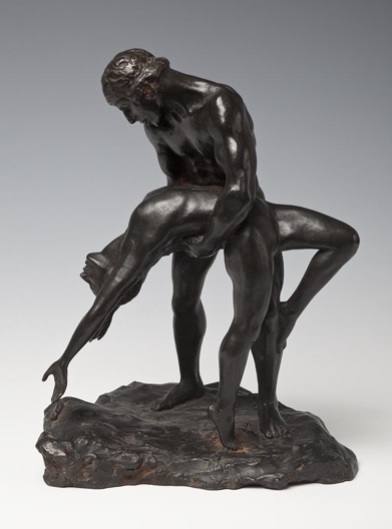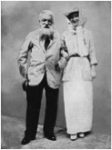
Malvina Hoffman
American, 1885-1966
Les Orientales, 1914
bronze
11¾ x 8 x 8¾ in.
SBMA, Gift of Mrs. George M. Newell
1946.5.2

Auguste Rodin and Malvina Hoffman, n.d. Unattributed portrait
“Art is an integral part of life. It has no age and no geography.” — Malvina Hoffman
RESEARCH PAPER
His arms gently encircling her waist as she arches backwards, arms extended, palms open, releasing joy or ecstasy. She balances on one foot, her other foot supported by his leg. He leans slightly forward, gazing intently, heartfully at her emotional abandonment. His arms hold her lovingly, gently. His body solidly anchored to the ground, his legs supporting their combined weight. His muscularity contrasting with the smooth, suppleness of her draping body. Nude, undefined by clothing, free, classic, timeless, sensual, loving, tender…the bodies “transcend the stillness of sculpture” (Conner, 140).
These figures by the American sculptor Malvina Hoffman represent Anna Pavlova (1881-1931) and Laurent Novikoff (1888-1956) in the pas de deux from ”Les Orientales”, a choreographic divertissement (1) which Hoffman might have seen in a performance by Pavlova’s ballet company in New York in 1913. Hoffman had recently become enthralled by ballet when she and her socially prominent mother were passing an extended time in Europe following the death of their father/husband Richard Hoffman, a classical pianist who performed often with the New York Philharmonic.
At the age of 25 she was recognized for her abilities as a sculptor. In her early years Hoffman was surrounded by the arts and in her teens studied at the Art Students League and with several artists, including Gutzon Borglum, who was later to carve the Mt. Rushmore National Memorial. Borglum encouraged her experiments with sculpting, and in 1910 her portrait bust of Samuel B. Grimson, a violinist friend of her father and whom she married in 1924, earned an honorable mention in the Salon of the Société Nationale des Beaux-Arts. (2)
1910 was a pivotal year for Hoffman. After much persistence, she was accepted as a student by Auguste Rodin and studied with him for sixteen months. During that time she also discovered the joy of ballet, having seen Diaghilev’s Ballets Russes both in Paris and London. She began a series of sculptures representing the grace and athleticism of the dance. Her initial work, titled “Russian Dancers”, portrayed Anna Pavlova and Mikhail Mordkin performing a dance in Alexander Glazunov’s “Autumn Bacchanale”.
After returning to New York, she followed the advice of Rodin and studied dissection and anatomy at the Columbia University College of Physicians and Surgeons from 1912 to 1914. She spent the summers of these years with Rodin, seeing him twice a week while also learning bronze casting, chasing, and finishing. Works produced during this time included Vaslav Nijinsky in “L’Après-midi d’un faune” and “Bacchanale Russe”, another piece from Glazunov’s “Autumn Bacchanale” with Pavlova and Mordkin. It won the first prize in the 1912 summer Salon of the Société Nationale des Beaux-Arts.
During 1913 she saw Pavlova’s company (she had left Diaghilev’s Ballets Russes after its first season) in New York, where the ballerina danced with Laurent Novikoff. In the following year Otto Kahn, chairman of the Metropolitan Opera, arranged for Hoffman to meet Anna Pavlova, and a life-long friendship and collaboration resulted. The major works of that year were “Les Orientales” with Pavlova and Novikoff and “Pavlova in La Gavotte”, continuing her ballet images.
In the summer of 1914 she had returned to be with Rodin in Paris but left early for New York because of the imminent war. On the way she visited Pavlova in London and proposed depicting the entire ballet “Autumn Bacchanale” in the form of a multi-panel bas-relief frieze with Pavlova posing for each part of the dance. The “Bacchanale Frieze” was completed in 1924 and consisted of 26 low-relief panels 24 inches high and extending for 50 feet! Unfortunately, it was never cast in a permanent material.
During World War I Hoffman was active in the Red Cross working for relief efforts. She continued producing both portrait busts (notably four different interpretations of Ignacy Paderewski as statesman, man, artist, friend) and the ballet (“La Peri”). Following the war in the 1920s she did several large works: a memorial piece in Harvard Chapel titled “The Sacrifice” and a monumental commission for Bush House in London titled “To the Friendship of the English Speaking People”. Her ballet inspired work included several portraits of Pavlova as well as the “Bacchanale Frieze” panels.
In 1929 Stanley Field commissioned Hoffman to produce a series of bronzes and marbles representing the peoples of the world to be housed in the Field Museum of Natural History in Chicago. She and her husband traveled the world for eight months, she sketching and he taking photographs. By the time of its unveiling at the 1933 Chicago World’s Fair, her “Races of Mankind” included 105 sculptures: 35 full figures, 1 half-size figure, 30 busts, and 39 heads.
With the death of Anna Pavlova in 1931, the ballet pieces from Hoffman came to an end. In 1936 she divorced her husband and published her first book, “Heads and Tales”, a description of their travels while working on the Field commission. “Sculpture Inside and Out”, an instructional volume, followed in 1939. She resumed her Red Cross aid to refugees work during World War II, and later produced numerous portrait busts, reliefs for the American WWII Memorial at Epinal, France, and a “History of Medicine” 13-panel façade at the Joslin Clinic in Boston. She completed her autobiography, “Yesterday Is Today”, in 1965.
Although Hoffman’s subject matter was exclusively the human form, her style was more diverse. The portrait busts are naturalistic, her dance pieces Romantic, occasionally with a hint of histrionics, and her “Mankind” sculptures “more anthropological studies than works of art” (Eden, 344). Regardless of the subject or medium, her art variously displays a thorough understanding of anatomy enhanced by a poetic grace of movement and an insight into the human condition.
In 1966 Malvina Hoffman died of a heart attack at the age of 81 in her New York City studio.
Notes:
(1) Divertissement (“enjoyable diversion”) is a classical ballet term for short dances added to a ballet to display more dancers’ talents or to lengthen what otherwise would be a short act.
(2) The Salon of the Société Nationale des Beaux-Arts was a secession from the official Paris Salon of the Académie des Beaux-Arts, created by several prominent artists (including Rodin) to exhibit young artists.
Prepared for the Santa Barbara Museum of Art Docent Council by Ralph Wilson, 2019.
Bibliography
Anderson, Janet A. “Malvina Hoffman.” In “Dictionary of Women Artists: Introductory Surveys: Artists, A-I”, edited by Delia Gaze, 705-706. Two Volume Set. Abingdon, Oxford, England: Routledge/Taylor & Francis, 1997. https://books.google.com/books?id=6_0Y0PALzQMC&pg=PA705&lpg=PA705&dq=rodin+hoffman&source=bl&ots=tWz5YKGtUR&sig=ACfU3U2MtqqfKgy5NfMQ0Mcp9vJ_dPs_Jw&hl=en&sa=X&ved=2ahUKEwiW- 7yuwK hAhUHLK0KHZWJADE4FBDoATACegQICRAB#v=onepage&q=rodin%20hoffman&f=false
Anonymous. “Malvina Hoffman Dead at Age of 81.” New York Times, July 11, 1966, 1, 29. Obituary.
--------. “Malvina Hoffman Honored at Rites.” New York Times, July 14, 1966, 36.
Barryte, Bernard. “Rodin and America: The artist’s influence in the United States.” The Magazine Antiques, November 1, 2011. http://www.themagazineantiques.com/article/rodin-and-america-the-artists-influence-in-the-united-states/
Conner, Janis. “The Ethereal Icon: Malvina Hoffman’s Worshipful Imagery of Anna Pavlova.” In “Perspectives on American Sculpture Before 1925”, edited by Taylor Tolles, 130-149. New York: Metropolitan Museum of Art, 2003.
Eden, Myrna Garvey. “Hoffman, Malvina Cornell.” In “Notable American Women: The Modern Period: a Biographical Dictionary”, edited by Barbara Sicherman and Carol Hurd Green, 343-345. Boston: Harvard University Press, 1980.
Websites
Anonymous. “Malvina Hoffman.” Smithsonian American Art Museum.
https://americanart.si.edu/artist/malvina-hoffman-2260
Anonymous. “The Hand of Rodin.” Metropolitan Museum of Art. https://www.metmuseum.org/art/collection/search/204715
Anonymous. “Malvina Hoffman.” Encyclopedia.com. This site contains the following articles:
“Malvina Cornell Hoffman” in “Encyclopedia of World Biography”
“Hoffman, Malvina” in “The Columbia Encyclopedia”, 6th ed.,
“Hoffman, Malvina” in “American Women Writers: A Critical Reference Guide from Colonial Times to the Present”
https://www.encyclopedia.com/people/literature-and-arts/american-art-biographies/malvina-hoffman
Hoffman, Didi. “Not Just Another Woman: August Rodin & Malvina Hoffman.” Poetry and Motion (blog). March 2, 2016. https://poetryandocean.wordpress.com/2016/03/02/auguste-rodin-malvina-hoffman/
SBMA CURATORIAL LABELS
A double portrait of the acclaimed Ballets Russes dancers Anna Pavlova and Laurent Novikoff, this sculpture shows the duo in a ballet first staged in 1913, which the young Philadelphian Malvina Hoffman would have seen in London. While in the actual ballet the dancers would have been clad in elaborately exotic costumes designed by Léon Bakst, the artist chooses to show the pair nude. As such, they have become timeless, suspended forever in a passionate and erotically-charged moment.
- Highlights of American Art, 2020
